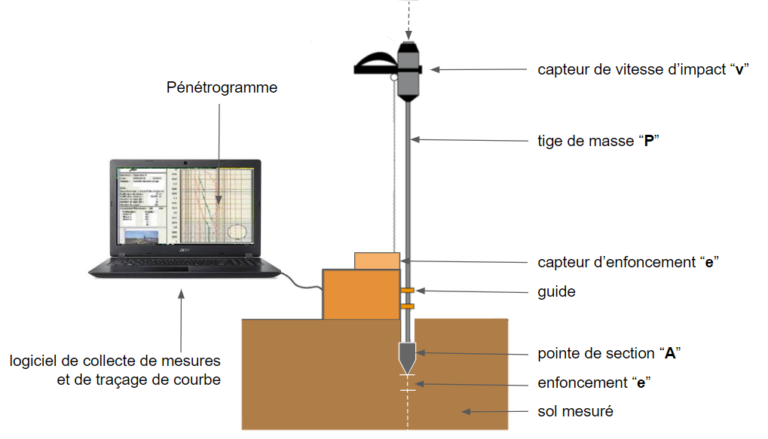
The test determines the resistance of soils and soft rocks to the dynamic penetration of a conical point.
To determine the quality of a type of field coupled with direct investigations (eg taking samples according to ISO 22475-1)
For all types of soil studies, before earthworks in the field of infrastructure (Building, Roads, Civil Engineering, etc.) and even in the construction of individual housing since the Elan Law of January 2020. For any geotechnical diagnosis during the maintenance phase of the structure (the structure being a building or any type of civil engineering construction). For controlling the compaction of trenches, embankments, etc.
STANDARD :
NF P EN ISO 22476-2 – link to AFNOR
This standard characterizes the Dynamic Penetration Test.
The descriptive terms are: geotechnical, soil, on-site test, penetration test, sounding, dynamic test, apparatus, dimension
The conical tip is beaten with a hammer of a given weight and falling from a given height. Penetration resistance is characterized by the number of strokes required to drive the conical tip to a set depth. The number of strokes, during continuous threshing, is noted as a function of the depth reached by the tip, but no sample is taken.
Threshing in various modes: 4 procedures cover a wide range of specific threshing energy per stroke: DPL (light dynamic), DPM (medium), DPH (heavy), DPSH (very heavy). Several configurations of weight and drop heights: DPL (10kg / 50cm), DPM (30kg / 50cm), DPH (50kg / 50cm), DPSH-A (63.5kg / 50cm), DPSH-B (63.5kg / 75cm) .
Before the publication of the ISO 22476 standard, the NF P 94-114 and NF 94-115 standards existed in France since 1990.
The type A dynamic penetrometer (PDA) is used to perform dynamic penetration tests which are considered as reference tests (NF P 94-114).
The type B dynamic penetrometer (PDB) is used to carry out soil reconnaissance surveys (NF P 94-115).
NF P 94-115 – link to AFNOR
The geotechnical study missions are defined by standard NF P94-500 (November 2013) and classified in G1, G2, G3, G4 and G5. The G1 consists of soil identification and includes soil strength testing at the tip of a penetrometer, as well as a sounding. The G2 includes a dimensional draft. The G3 includes the monitoring of work on site by a geotechnical engineer. The G4 includes an execution study and the G5 consists of a diagnostic during the life of the structure and must determine the causes of the damage to the structure, taking into account its history.
SAMPLE COLLECTION BY THRESHING
NF P EN ISO 22476-3 – link to AFNOR
This sample collection test by beating with a corer is called the Standard SPT Penetration Test.
Variable Energy Dynamic Penetrometers
Constant Energy Dynamic Penetrometers
Constant or variable energy dynamic penetrometers